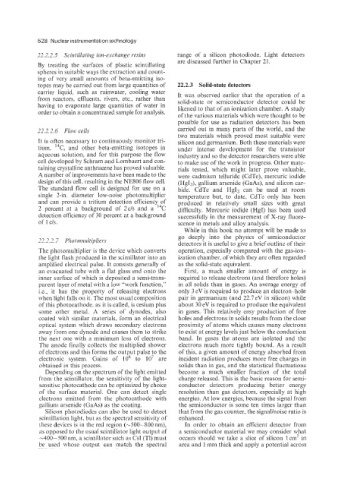Page 546 - Instrumentation Reference Book 3E
P. 546
528 Nuclear instrumentation technology
22.2.2.5 Scintillating ion-exchange resins range of a silicon photodiode. Light detectors
are discussed further in Chapter 21.
By treating the surfaces of plastic scintillating
spheres in suitable ways the extraction and count-
ing of very small amounts of beta-emitting iso-
topes may be carried out from large quantities of 22.2.3 Solid-state detectors
carrier liquid. such as rainwater, cooling water It was observed earlier that the operation of a
from reactors, effluents, rivers, etc., rather than solid-state or semiconductor detector could be
having to evaporate large quantities of water in likened to that of an ionization chamber. A study
order to obtain a concentrated sample for analysis. of the various materials which were thought to be
possible for use as radiation detectors has been
22.2.2.6 Flow cells carried out in many parts of the world, and the
two materials which proved most suitable were
It is often necessary to continuously monitor tri- silicon and germanium. Both these materials were
tium, I4C, and other beta-emitting isotopes m under intense development for the transistor
aqueous solution, and for this purpose the flow industry and so the detector researchers were able
cell developed by Schram and Lonibaert and con- to make use of the work in progress. Other mate-
taining crystalline anthracene has proved valuable. rials tested, which might later prove valuable,
A number of improvements have been made to the were cadmium telluride (CdTe), mercuric iodide
design of this cell, resulting in the NE806 flow cell. (HgIz), gallium arsenide (GaAs), and silicon car-
The standard flow cell is designed for use on a bide. CdTe and Hg12 can be used at room
single 2-in. diameter low-noise photomultiplier temperature but, to date, CdTe only has been
and can provide a tritium detection efficiency of produced in relatively small sizes with great
2 percent at a background of 2cIs and a “C difficulty. Mercuric iodide (HgI) has been used
detection efficiency oE 30 percent at a background successfully in the measurement of X-ray fluore-
of 1 CIS. scence in metals and alloy analysis.
While in this book no attempt will be made to
go deeply into the physics of semiconductor
22.227 PI10 toinultipliei*s
detectors it is useful to give a brief outline of their
The photomultiplier is the device which converts operation, especially compared with the gas-ion-
the light flash produced in the scintillator into an ization chamber, of which they are often regarded
amplified electrical pulse. It consists generally of as the solid-state equivalent.
an evacuated tube with a flat glass end onto the First. a much smaller amount of energy is
inner surface of which is deposited a semi-trans- required to release electrons (and therefore holes)
parent layer of metal with a low “work function,” in all solids than in gases. An average energy of
Le., it has the property of releasing electrons only 3 eV is required to produce an electron-hole
when light falls on it. The most usual composition pair in germanium (and 22.7eV in silicon) while
of this photocathode, as it is called, is cesium plus about 30 eV is required to produce the equivalent
some other metal. A series of dynodes, also in gases. This relatively easy production of free
coated with similar materials, form an electrical holes and electrons in solids results from the close
optical system which draws secondary electrons proximity of atoms which causes many electrons
away from one dynode and causes them to strike to exist at energy levels just below the conduction
the next one with a minimum loss of electrons. band. In gases the atoms are isolated and the
The anode finally collects the multiplied shower electrons much more tightly bound. As a result
of electrons and this forms the output pulse to the of this, a given amount of energy absorbed from
electronic system. Gains of lo6 to lo7 are incident radiation produces more free charges in
obtained in this process. solids than in gas, and the statistical fluctuations
Depending on the spectrum of the light emitted become a much smaller fraction of the total
from the scintillator, the sensitivity of the light- charge released. This is the basic reason for semi-
sensitive photocathode can be optimized by choice conductor detectors producing better energy
of the surface material. One can detect single resolution than gas detectors, especially at high
electrons emitted from the photocathode with energies. At low energies, because the signal from
gallium arsenide (GaAs) as the coating. the semiconductor is some ten times larger than
Silicon photodiodes can also be used to detect that from the gas counter, the signalhoise ratio is
scintillation light, but as the spectral sensitivity of enhanced.
these devices is in the red region (-500-800nm), In order to obtain an efficient detector from
as opposed to the usual scintillator light output of a semiconductor material we may consider what
-400-500 nm, a Scintillator such as CsI (Tl) must occurs should we take a slice of silicon 1 cm’ in
be used whose output can match the spectral area and 1 mm thick and apply a potential across

